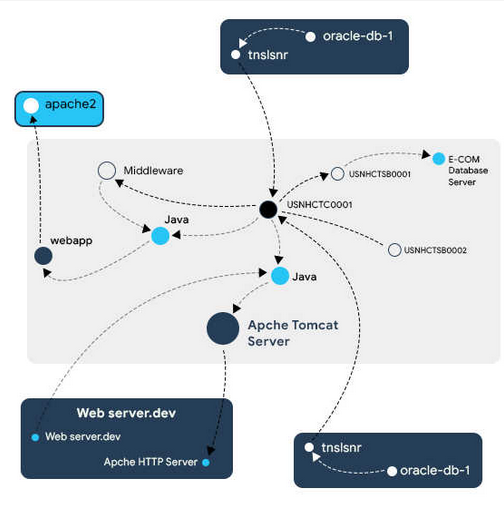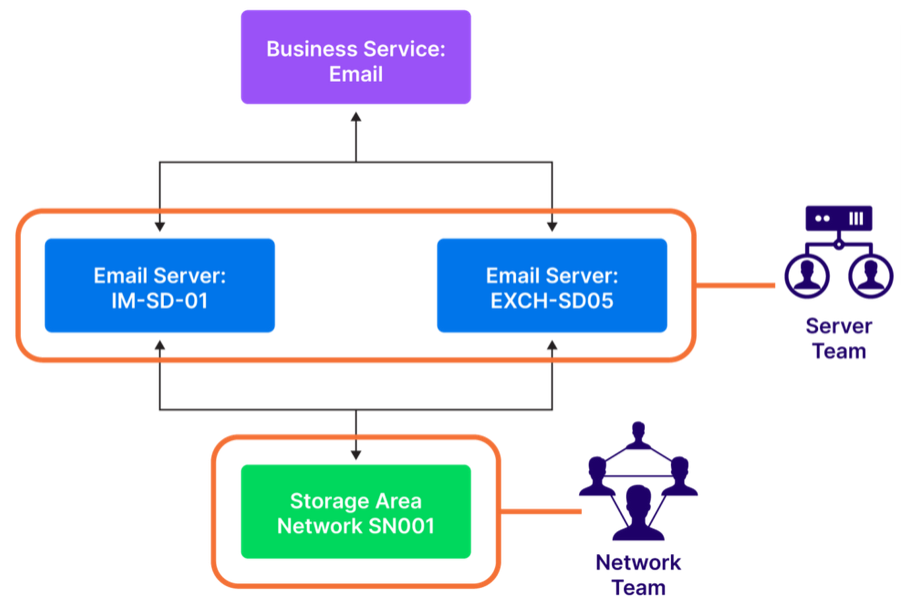CMDB vs Asset Management: Key Distinctions Explained
Understanding the differences between CMDB and asset management is crucial to deriving the full value from investments made in an enterprise’s IT infrastructure and applications. The ISO/IEC 19770-1:2017 standard defines asset management as the coordinated activity of an organization to realize value from any item being used to acquire, process, store, and distribute digital information. The ISO/IEC 20000-1:2018 standard defines a configuration item as an element that needs to be controlled in order to deliver services.
Asset management looks at the lifecycle of the IT asset, while configuration management focuses on the asset’s interrelation with other IT assets in the delivery of IT services. The CMDB is the IT solution through which this interrelation is recorded as a series of connections and dependencies.
There are several ways to compare CMDBs and asset management. In this article, we consider four dimensions of note: focus area, value proposition, tooling, and use cases. The scope to be covered will mainly focus on IT service management practices. This article will not go into in-depth details on business financial management related to how assets are accounted for and depreciated or specific details of what tools an organization should procure.
Summary of CMDB vs asset management key concepts
Here is a summary of the main dimensions to be compared.
| Dimension | CMDB | Asset Management |
|---|---|---|
| Focus area | Relationships and interdependencies | Individual item and lifecycle status |
| Value proposition | Technical value | Business value |
| Tooling | Single source of truth | Inventory lists |
| Use cases | Change management, incident management, and problem management | Service financial management and architecture management |
Focus area
While both CMDBs and asset management concentrate their attention on the same elements, the focus area differentiates them. A CMDB is oriented toward keeping and managing configuration item (CI) records and the relationships among them. These CIs are the ones that are in use, such as a core router carrying the backbone traffic in a data center or a software license required to enable users and applications to access required services. The CMDB provides much-needed visibility into relationships among CIs, which can be visualized for the purposes of planning changes or troubleshooting incidents. For instance, an application’s dependence on a database, switch port, or API can be discovered, the baseline information recorded, and any changes to that baseline tracked automatically.

Figure 1: Sample CMDB Dependency Map (source)
In contrast, the focus of asset management is on the existence of the individual asset, whether it is in use or not. The asset lifecycle covers the IT asset from the moment it is procured and stored, then tracks its deployment and assignment through final decommissioning and disposal. The imperative here is to have trustworthy data about the IT assets, with a view to optimizing efficiency and cost-effectiveness. The key information captured in asset management includes the asset’s date of acquisition, financial value, assignment, and status, which would be tracked in an asset register.
Value proposition
The value proposition is a direct offshoot of the focus area in comparing CMDBs with asset management. The business value for a CMDB is derived from its technical usage, especially when IT services are accurately mapped for their underlying elements such as applications, databases, storage, servers, and networking. An updated CMDB can play a huge role in reducing mean time to repair (MTTR) by helping IT teams quickly pinpoint the sources and impacts of outages caused by faulty CIs.
According to the Uptime Institute’s most recent annual outage analysis report, human error and management failures contribute to a considerable number of outages. A CMDB can limit this by providing accurate information on dependencies that can help with more thorough change planning and faster incident resolution. For this reason, if the CMDB is not updated, its value goes down—a well-managed CMDB will undergo regular audits to validate its value proposition.
For asset management, the value proposition is mainly based on financial practices that directly affects the organization’s bottom line. Whenever IT assets are well managed, the value includes optimized costs, reduced risks, and better compliance with policies and regulations. No CEO will be impressed when IT has set up hundreds of instances that do not carry traffic or purchased expensive software licenses that are not deployed. By tracking the status of the IT asset through its asset lifecycle, the enterprise will be in a better position to make decisions on infrastructure refreshes or to accurately value the business in the case of a merger or acquisition.
IT asset utilization may not be a direct factor when it comes to financial value, since the asset depreciates over time, may be lost or mishandled while in storage, or might be disposed of at an inappropriate time. Asset management, when well executed, will ensure that information about status is communicated to the right stakeholders so that decisions that generate the most value from the IT asset can be made.
Tooling
Having a tool to manage records is critical for both the CMDB and asset management. Some organizations are just starting their journeys, so a simple spreadsheet works for them when it comes to managing a handful of IT assets and CIs. However, as the scope and complexity increase, their effectiveness will be greatly hampered. A specialized IT solution provides better value in the long run in harnessing information about the asset lifecycle as well as discovering dependencies and configuration changes.
A CMDB requires a tool that enables it to be a single source of truth. The CMDB as a tool needs to discover the CIs in the organization’s network as well as on cloud instances procured from third-party providers. Discovery needs to be configured to be automated so that the tool is able to update configuration information from the initial baseline and provide delta information on the changes encountered. The right CMDB solution will support both agent and agentless discovery, cut across all environments whether on-premise or cloud, and comprehensively generate application dependency maps demonstrating application-to-device relationships.
Multiple CMDBs complicate the value proposition in terms of technical usage and maintenance, especially if the value from the CMDB is in quickly diagnosing sources of unavailability and degradation in IT services. A single CMDB covering the entire IT landscape is the best solution for any organization.
For asset management, the tool requirement is one that tracks the lifecycle of the IT asset and relates it to financial information—especially the current value. According to ITIL 4, the structure of the automated IT asset register may include entities, attributes, lifecycle stages, interfaces between the IT asset register and related tools, and role-based access, among other capabilities.
There would usually not be a stringent requirement for a single asset management tool in an organization, even though it is preferable. For instance, an IT team can rely on a cloud service provider’s portal to track its cloud assets while using an internal tool for on-premises equipment. Meanwhile, the finance function would track IT asset information separately using an ERP for acquisition, depreciation, and tracking storage. At the end of the day, what matters is the consolidation of information for reporting purposes.
Use cases
The CMDB plays a crucial role in making the operational practices of IT service management more effective. When the CMDB is updated with the current CIs and their relationships, practices such as change management have a better chance of pinpointing the impact of change through CMDB dependency mapping. In addition, practices such as incident and problem management can reduce analysis time of sources of outages and degradation if the CMDB data is readily available. Configuration information is most valuable when applied to impact analysis, cause and effect analysis, risk analysis, cost allocation, availability analysis, and planning. For example, the right CMDB solution can visualize application-to-device dependency, and facilitate incident root-cause analysis since teams can zero in on the relevant system elements that are impacting the associated business service.

Figure 2: Use of CMDB data in an incident investigation (source)
On the other hand, while asset management is a practice in itself when you consider the management of the IT asset lifecycle, its use case is heavily enabled by service financial management to drive business value discussions on IT asset status. From the moment the procured IT asset is available to IT administrators, the IT asset register should track its financial value, using that information to support decisions for effective IT asset utilization. For example, architecture roadmap decisions can be better informed from a financial perspective when asset financial information is available. Decisions to refresh or dispose of IT assets can only be effective when their financial journey is tracked alongside the lifecycle by ensuring that servicing and repair information, costs of upgrades, and vendor maintenance contract details go hand in hand with the status.
Recommendations
When it comes to CMDB vs asset management, the organizational focus determines whether you need one, the other, or both. For this reason, enterprises should use the right information for the right purposes. Tracking dependencies and applying the information in service operations activities is best suited to CMDBs. On the other hand, the asset management practice is the go-to approach for tracking the IT lifecycle and relating it to the financial perspective.
It is highly beneficial for enterprises to consider maximizing IT tools that can give them the best of both worlds. Investing in a CMDB that can track the lifecycle of the entire IT infrastructure, including the cloud, and can be integrated with the organization’s financial management system can bridge the two worlds together. The result is greater value extraction in a more efficient manner.
Conclusion
Understanding the difference between CMDBs and asset management is the first step in making the right decisions to maximize IT value. They may have differing perspectives, but they complement each other to provide a comprehensive view of an organization’s IT infrastructure. The CMDB provides detailed technical information about CIs, while asset management provides lifecycle and associated financial information. Together, they are invaluable in enabling enterprises to better manage their IT resources and optimize their IT investments.




